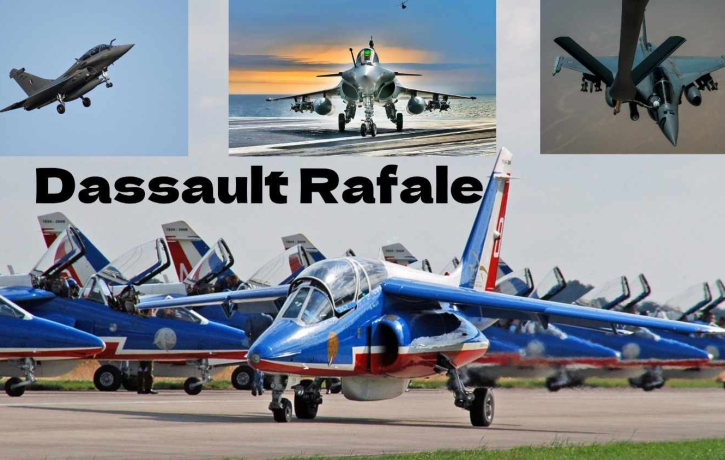✈️ Dassault Rafale: France’s Premier Multi-Role Combat Aircraft
The Dassault Rafale jet Specification, a product of French aerospace excellence, stands as one of the most versatile and combat-ready fighter jets in the world. Built by Dassault Aviation, the Rafale is a 4.5-generation aircraft designed to perform multiple missions, from air supremacy to ground support, with remarkable precision and agility.
?️ Origin and Development
The Rafale’s origins trace back to the late 1970s and early 1980s, when France sought to develop an independent, Indigenous fighter aircraft capable of replacing multiple aircraft types in the French Air Force and Navy. Instead of joining the multinational Eurofighter Typhoon program, France opted to develop its aircraft, leading to the creation of the Rafale program in 1986.
The prototype, Rafale A, took its first flight on July 4, 1986, and the aircraft officially entered service with the French Navy in 2004, followed by the French Air Force in 2006.
? Design and Avionics
The Rafale features a delta wing with canard foreplanes, giving it excellent maneuverability and aerodynamic efficiency. Its airframe is made with composite materials, reducing radar cross-section and enhancing stealth characteristics.
Key features include:
-
Glass Cockpit: Fully digital with wide-angle holographic heads-up display (HUD), touch-screen interface, and voice command capability.
-
RBE2 Radar: An advanced AESA (Active Electronically Scanned Array) radar capable of detecting multiple targets over long distances.
-
SPECTRA EW System: An integrated electronic warfare suite for radar jamming, threat detection, and countermeasures.
-
Modular Open Architecture: Allows easy upgrades and integration of new weapons and systems.
? Weapons and Armament
The Dassault Rafale jet Specification is renowned for its “Omnirole” capability, which enables it to perform air-to-air, air-to-ground, reconnaissance, and nuclear deterrence missions in a single sortie. It supports a wide variety of weapons:
-
Air-to-Air Missiles: MICA, Meteor (long-range), Magic II
-
Air-to-Ground Weapons: SCALP-EG cruise missile, AASM guided bombs, Hammer bombs
-
Nuclear Armament: ASMP-A nuclear missile (for French strategic forces)
-
Cannon: 30mm GIAT 30 internal gun
? Variants
The Rafale exists in multiple variants to meet different operational needs:
-
Rafale C: Single-seat version for the French Air Force
-
Rafale B: Two-seat version for training and strike missions
-
Rafale M: Naval version for aircraft carrier operations (catapult-launched and tail-hook equipped)
? Global Operators and Exports
Originally developed for domestic use, the Rafale eventually found global interest due to its versatility and combat track record. Notable international customers include:
-
India: Purchased 36 Rafale jets under an inter-governmental deal. Indian Rafales are equipped with India-specific enhancements, including Israeli-made HMDS, enhanced radar, and advanced EW systems.
-
Egypt: Operates Rafales for multi-role air superiority and deep-strike missions.
-
Qatar: Acquired Rafales to modernize its air force.
-
Greece and Croatia: Joined the list of European nations operating the Rafale, primarily for regional air defense and NATO operations.
? Performance Specifications
-
Top Speed: Mach 1.8 (approx. 2,222 km/h)
-
Range: 3,700 km (ferry range with drop tanks)
-
Combat Radius: Approx. 1,850 km
-
Service Ceiling: 50,000 feet
-
Rate of Climb: 60,000 ft/min
-
Thrust/Weight Ratio: Greater than 1, enabling excellent dogfighting agility
?️ Combat Record
Though not as heavily deployed as American aircraft, the Rafale has seen significant action in multiple theatres:
-
Libya (2011): Strikes against the Gaddafi regime during NATO’s Operation Unified Protector.
-
Mali: Used for precision strikes during France’s counter-terror operations in the Sahel region.
-
Syria and Iraq played a key role in Operation Chammal against ISIS.
-
Balakot Airstrike (2019): While not used, Indian Rafales were acquired with such strike scenarios in mind.
? Strategic Importance
The Rafale represents more than just an aircraft—it is a symbol of French defense autonomy and technological prowess. Its ability to seamlessly switch roles mid-flight makes it one of the most flexible fighters in service today.
For countries like India, acquiring the Rafale was seen as a major force multiplier, improving air defense and precision strike capabilities significantly. With ongoing upgrades like the F4 and future F5 standards, the Rafale continues to evolve and remain relevant in an era dominated by stealth and electronic warfare.
✅ Conclusion
The Dassault Rafale jet Specification stands as a benchmark for 4.5-generation multi-role fighters. Combining stealth, speed, agility, and technology, it offers nations an all-in-one combat aircraft capable of excelling in any mission profile. As the global security environment grows more complex, the Rafale continues to soar as a trusted guardian of the skies—battle-proven, future-ready, and strategically irreplaceable.

